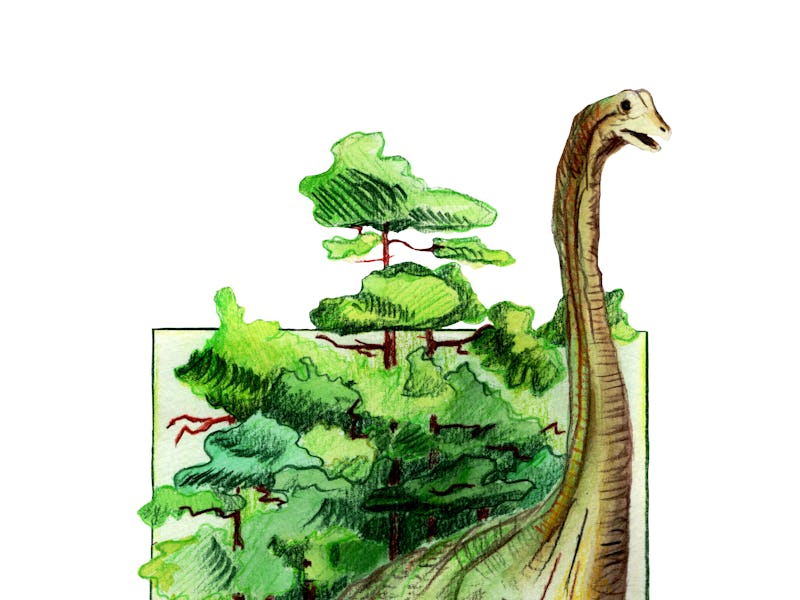3D scans reveal what a dinosaur hatchling looked like
Computer scans bring researchers face-to-face with brontosaurus relatives.

Long necks and tiny heads, like those of brontosaurus, make sauropod dinosaurs instantly recognizable. Since they roamed Earth 80 million years ago, these four-legged herbivores still hold the record as the largest ever to live, reaching up to 80 tons.
Researchers are uncovering new clues about what the massive dinosaur group's faces looked like — specifically, how they looked as babies.
In a new study, researchers describe the facial structure of the embryos of sauropod dinosaurs. The baby dino had a monocerotic, or single-horned, face, the researchers report — an unusual feature for a sauropod. The analysis finds evidence of stereoscopic vision development.
Paired with what we already know about the faces of adult sauropods, the findings suggest the dinosaurs had specialized facial features as hatchlings. The babies' bony heads may have helped them hatch out of the egg — rather than using a bony egg tooth to break free. As they matured, the dinosaurs' faces morphed, too.
Scientists created a 3D model of the preserved skull to reconstruct its form.
Titanosaurian embryo skull (top), 3d face reconstruction (below), and head reconstruction (inset).
Researchers believe the specimen is a titanosaurian dinosaur, a type of sauropod. It is the first of its kind to be preserved in 3D, study author Martin Kundrát said in a statement.
"The most striking feature is head appearance, which implies that hatchlings of giant dinosaurs may differ in where and how they lived in their earliest stages of life," Kundrat said.
New analysis, old skull — The skull described in the new study was part of a discovery made 25 years ago. Paleontologists discovered sauropod embryos in a large nesting ground in Patagonia, Argentina.
Sauropod skull and reconstruction.
The skull's precise origin isn't known because it was illegally exported from Argentina. It was later returned for further study, and is housed at a museum.
In the new study, researchers used a new technique called synchrotron microtomography to image the bone, tooth, and soft tissue structures of the embryo. The scans revealed new, incredible details, like tiny teeth.
The baby dino skull is nearly intact, and it differs from other breeding ground samples in its size and facial anatomy, the researchers report. It's possible that the sample represents of new species of titanosaurian, they say.
Renderings of the sauropod embryo's face and head.
The study presents a new theory of what the faces of baby titanosaurian dinosaurs looked like — and how they may have changed as the babies grew.
"Our study revealed several new aspects about the embryonic life of the largest herbivorous dinosaurs that lived on our planet," Kundrat said.
"A horned faced and binocular vision are features quite different from what we expected in titanosaurian dinosaurs."
Abstract: The first dinosaur embryos found inside megaloolithid eggs from Auca Mahuevo, Patagonia, were assigned to sauropod dinosaurs that lived approximately 80 million years ago. Discovered some 25 years ago, these considerably flattened specimens still remain the only unquestionable embryonic remains of a sauropod dinosaur providing an initial glimpse into titanosaurian in ovo ontogeny. Here we describe an almost intact embryonic skull, which indicates the early development of stereoscopic vision, and an unusual monocerotic face for a sauropod. The new fossil also reveals a neurovascular sensory system in the premaxilla and a partly calcified braincase, which potentially refines estimates of its prenatal stage. The embryo was found in an egg with thicker eggshell and a partly different geochemical signature than those from the egg-bearing layers described in Auca Mahuevo. The cranial bones are comparably ossified as in previously described specimens but differ in facial anatomy and size. The new specimen reveals significant heterochrony in cranial ossifications when compared with non-sauropod sauropodomorph embryos, and demonstrates that the specialized craniofacial morphology preceded the postnatal transformation of the skull anatomy in adults of related titanosaurians